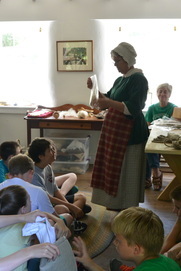How Many Shirts Do You Have?
Welcome to Newlin Grist Mill. This week I am taking 300 school kids to the 18th century. That’s 100 kids a day for three days. Fortunately, I am not alone in this endeavor.
The kids and their teachers will have a hands on experience of sand casting metal gears, cooking on an open hearth, making bricks, blacksmithing, milling corn meal, and making cloth. In addition they will be signed up as apprentices at the mill. Apprenticeship was a good way to get an education in a time and place where only 3% of the population (generally a hand full of rich white males) had access to college.
 I'm the cloth lady. First we discuss the differences between synthetic fabrics and natural fabrics. Then we talk about silk, wool, cotton and linen, the fibers I am wearing (no wool in the 90 degree heat, no silk either, too expensive and showy for a Quaker miller's wife).
I'm the cloth lady. First we discuss the differences between synthetic fabrics and natural fabrics. Then we talk about silk, wool, cotton and linen, the fibers I am wearing (no wool in the 90 degree heat, no silk either, too expensive and showy for a Quaker miller's wife).
I do third person interpretation. That is, though I am dressed in period clothing, I present myself as a modern historian, so I can talk about KB's daily life, where I can go to the store and buy clothes, as well as the life of the Miller's Wife who had to make her own or arranged for someone else to make them.
I do have a tendency to slip into first person interpretation in which I present the point of view of the Millers Wife. "I am busy feeding two meals a day to about 20 people so I don't have time to make my own clothing."
We talk about what fabric is used for what purpose (wool for warmth, linen for coolness, cotton for versatility, silk for elegance), the cost of each to produce. Cost means not only cost in money but time, difficulty in processing, access to the raw materials and skill in the many processes in making cloth.
One thing we don't talk about is mending. Patching and darning were important skills when you get only one set of cloths a year.
OK, so cloth making is nowhere near as exciting a casting a gear with molten metal, or working over a forge to produce a horse shoe, or taking off you shoes and stomping on wet clay to make a brick, or eating a cookie you baked in a Dutch oven. But I bet not one of those kids has ever thought about where his or her clothing comes from or how lucky they are to have a drawer full of t-shirts.
My real concern is that after 300 kids in three days, am I going to be able to get out of bed the next day?
The kids and their teachers will have a hands on experience of sand casting metal gears, cooking on an open hearth, making bricks, blacksmithing, milling corn meal, and making cloth. In addition they will be signed up as apprentices at the mill. Apprenticeship was a good way to get an education in a time and place where only 3% of the population (generally a hand full of rich white males) had access to college.
 I'm the cloth lady. First we discuss the differences between synthetic fabrics and natural fabrics. Then we talk about silk, wool, cotton and linen, the fibers I am wearing (no wool in the 90 degree heat, no silk either, too expensive and showy for a Quaker miller's wife).
I'm the cloth lady. First we discuss the differences between synthetic fabrics and natural fabrics. Then we talk about silk, wool, cotton and linen, the fibers I am wearing (no wool in the 90 degree heat, no silk either, too expensive and showy for a Quaker miller's wife).I do third person interpretation. That is, though I am dressed in period clothing, I present myself as a modern historian, so I can talk about KB's daily life, where I can go to the store and buy clothes, as well as the life of the Miller's Wife who had to make her own or arranged for someone else to make them.
I do have a tendency to slip into first person interpretation in which I present the point of view of the Millers Wife. "I am busy feeding two meals a day to about 20 people so I don't have time to make my own clothing."
We talk about what fabric is used for what purpose (wool for warmth, linen for coolness, cotton for versatility, silk for elegance), the cost of each to produce. Cost means not only cost in money but time, difficulty in processing, access to the raw materials and skill in the many processes in making cloth.
One thing we don't talk about is mending. Patching and darning were important skills when you get only one set of cloths a year.
OK, so cloth making is nowhere near as exciting a casting a gear with molten metal, or working over a forge to produce a horse shoe, or taking off you shoes and stomping on wet clay to make a brick, or eating a cookie you baked in a Dutch oven. But I bet not one of those kids has ever thought about where his or her clothing comes from or how lucky they are to have a drawer full of t-shirts.
My real concern is that after 300 kids in three days, am I going to be able to get out of bed the next day?
Published on June 15, 2016 03:44
No comments have been added yet.
The Shepherd's Notes
Combining Living History and writing historical mysteries.
- K.B. Inglee's profile
- 22 followers



